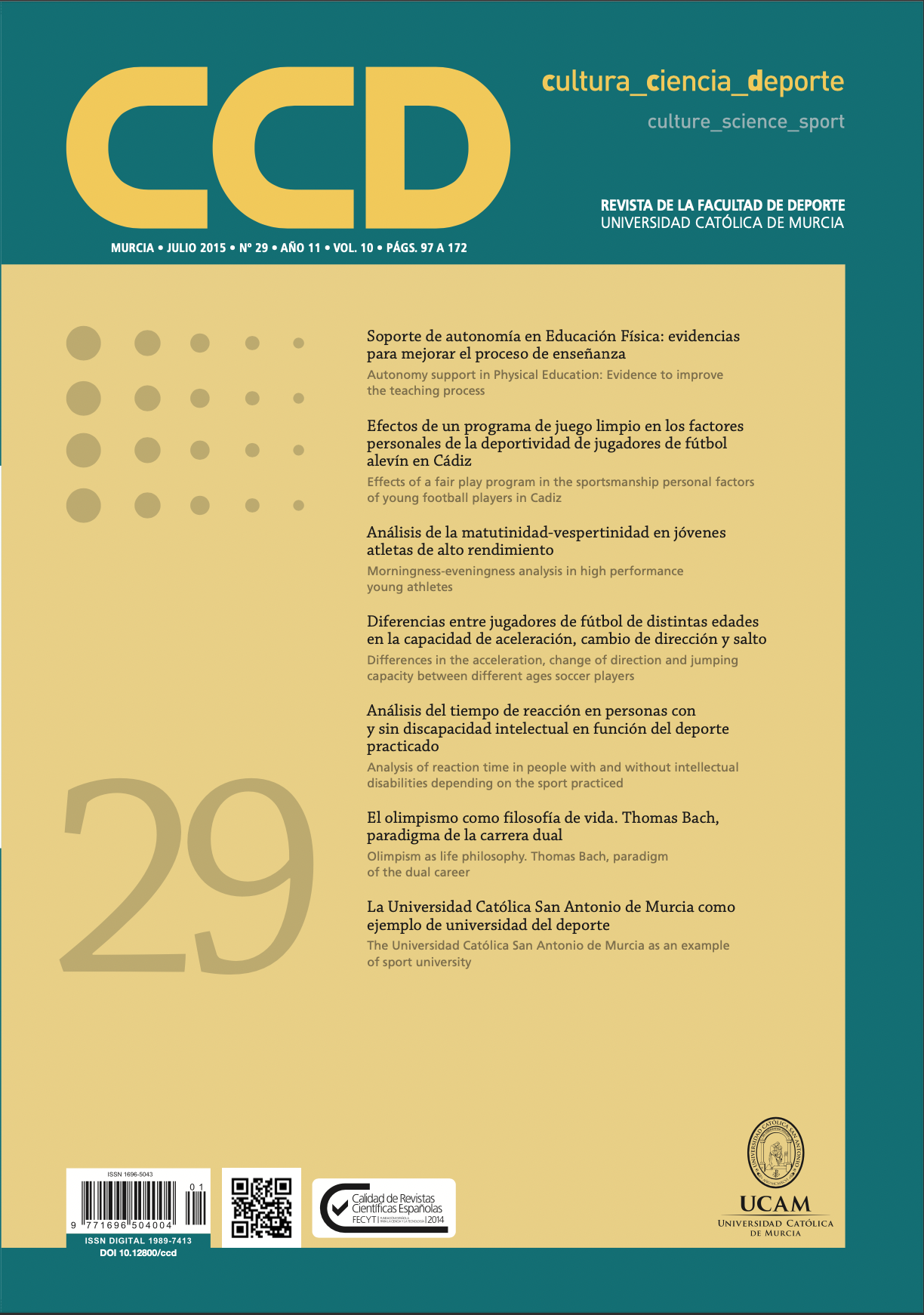Análisis del tiempo de reacción en personas con y sin discapacidad intelectual en función del deporte practicado. (Analysis of reaction time in people with and without intellectual disabilities depending on the sport practiced).
DOI:
https://doi.org/10.12800/ccd.v10i29.560Resumen
http://dx.doi.org/10.12800/ccd.v10i29.560
El objetivo de este estudio ha sido analizar las diferencias en cuanto al tiempo de reacción (TR) ante un estímulo visual entre deportistas con discapacidad intelectual y sin discapacidad, así como comparar las diferencias en función del género y el deporte que se practica. Para ello participaron un total de 38 deportistas (19 con discapacidad intelectual y 19 sin discapacidad) divididos en función del deporte que practicaban: atletismo, natación, deportes colectivos, gimnasia y artes marciales. El instrumento utilizado fue el Dynavision D2, un reacciómetro visual que manda estímulos de forma sucesiva a los deportistas para que respondan de forma rápida. Se demostró que el TR es menor en deportistas sin discapacidad en comparación a deportistas con discapacidad (p < 0.05), no apreciándose diferencias significativas en el TR entre sujetos con y sin discapacidad que realizaban artes marciales, ni al comparar cada grupo entre los distintos deportes practicados. Los valores medios de tiempo de reacción son mayores en hombres que en mujeres en ambos grupos, aunque no se apreciaron diferencias significativas entre ellos. Los resultados de este estudio ayudarían a planificar mejor el entrenamiento de estos deportistas.
Palabras clave: tiempo de reacción, discapacidad intelectual, estímulo visual, dynavisión.
===
Abstract
The aim of this study was to analyze the differences in the reaction time (RT) to a visual stimulus between athletes with intellectual disabilities and without disabilities, as well as to compare the differences in gender and sport practiced. 38 athletes took part in the study (19 with intellectual disabilities and 19 without disabilities) divided according to the sport practiced; athletics, swimming, team sports, gymnastics and martial arts. The instrument used was the Dynavision D2, a speed of reaction meter that sends stimuli in succession to the athletes so that they react rapidly. It was demonstrated that the RT is lower in athletes without disability compared with athletes with intellectual disability (p < 0.05). There being no significant differences in RT between subjects with and without disabilities who engaged in martial arts and when comparing each group among the different popular sports. The mean values of RT are higher in men than in women in both groups, although there was no significant difference between them. The results of this study will help to plan the training of these athletes.
Key words: reaction time, intellectual disability, visual stimulus, dynavision.
El objetivo de este estudio ha sido analizar las diferencias en cuanto al tiempo de reacción (TR) ante un estímulo visual entre deportistas con discapacidad intelectual y sin discapacidad, así como comparar las diferencias en función del género y el deporte que se practica. Para ello participaron un total de 38 deportistas (19 con discapacidad intelectual y 19 sin discapacidad) divididos en función del deporte que practicaban: atletismo, natación, deportes colectivos, gimnasia y artes marciales. El instrumento utilizado fue el Dynavision D2, un reacciómetro visual que manda estímulos de forma sucesiva a los deportistas para que respondan de forma rápida. Se demostró que el TR es menor en deportistas sin discapacidad en comparación a deportistas con discapacidad (p < 0.05), no apreciándose diferencias significativas en el TR entre sujetos con y sin discapacidad que realizaban artes marciales, ni al comparar cada grupo entre los distintos deportes practicados. Los valores medios de tiempo de reacción son mayores en hombres que en mujeres en ambos grupos, aunque no se apreciaron diferencias significativas entre ellos. Los resultados de este estudio ayudarían a planificar mejor el entrenamiento de estos deportistas.
Palabras clave: tiempo de reacción, discapacidad intelectual, estímulo visual, dynavisión.
===
Abstract
The aim of this study was to analyze the differences in the reaction time (RT) to a visual stimulus between athletes with intellectual disabilities and without disabilities, as well as to compare the differences in gender and sport practiced. 38 athletes took part in the study (19 with intellectual disabilities and 19 without disabilities) divided according to the sport practiced; athletics, swimming, team sports, gymnastics and martial arts. The instrument used was the Dynavision D2, a speed of reaction meter that sends stimuli in succession to the athletes so that they react rapidly. It was demonstrated that the RT is lower in athletes without disability compared with athletes with intellectual disability (p < 0.05). There being no significant differences in RT between subjects with and without disabilities who engaged in martial arts and when comparing each group among the different popular sports. The mean values of RT are higher in men than in women in both groups, although there was no significant difference between them. The results of this study will help to plan the training of these athletes.
Key words: reaction time, intellectual disability, visual stimulus, dynavision.
Descargas
Cómo citar
Número
Sección
Licencia
Los autores que publican en esta revista están de acuerdo con los siguientes términos:- Los autores conservan los derechos de autor y garantizan a la revista el derecho de ser la primera publicación del trabajo al igual que licenciado bajo una Creative Commons Attribution License que permite a otros compartir el trabajo con un reconocimiento de la autoría del trabajo y la publicación inicial en esta revista.













